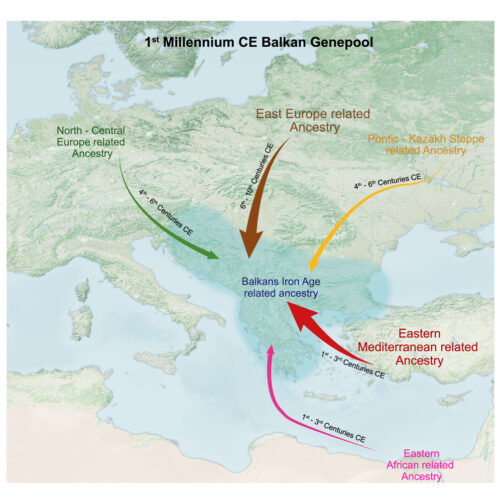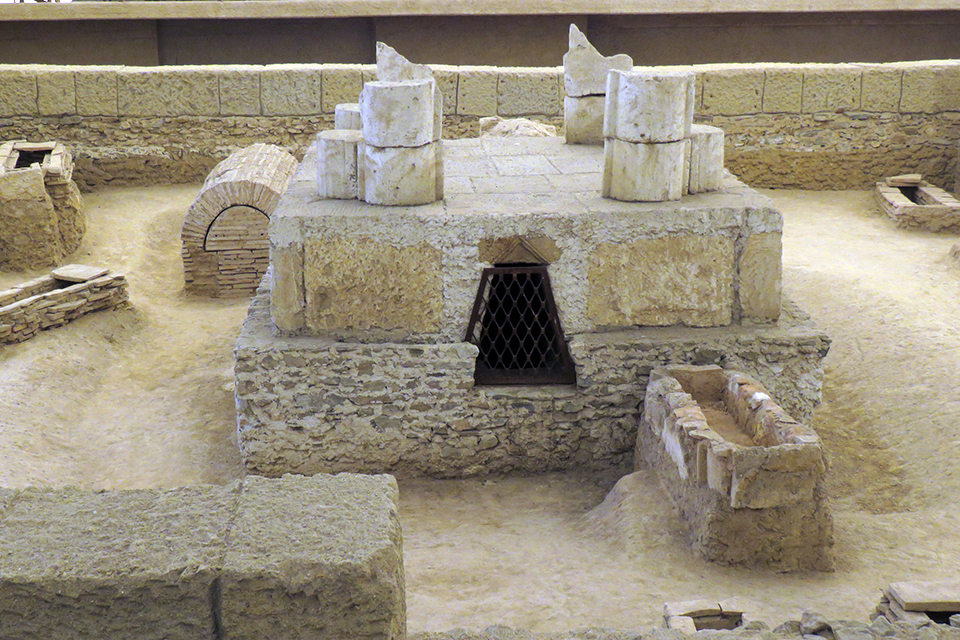A recent study of the aDNA from 146 individuals buried in Serbia and Croatia demonstrates the cosmopolitan mixture of people in Late Antiquity

A few years ago, the study of aDNA was expensive and complicated. Today, archaeologists are widely pursuing answers to old questions, such as
- How cosmopolitan were the new regional centres – for instance, in the Balkans – from the 3rd century onwards?
- Were the Goths a distinct “people” or a result of ethnogenesis?
- How many spoke Slavic, Germanic or Latin during the different periods?
As part of the new study of the aDNA, the team recovered and analysed whole genome data from 146 ancient people excavated primarily from Serbia and Croatia. More than a third of these individuals came from the Roman military frontier at the massive archaeological site of Viminacium located 40 km west of Belgrade in Serbia. These data were co-analysed with data from the rest of the Balkans and nearby regions.
The work, published in the journal Cell, highlights the cosmopolitanism of the Roman frontier and the long-term consequences of migrations that accompanied the breakdown of Roman control, including the arrival of people speaking Slavic languages. Archaeological DNA reveals that despite nation-state boundaries that divide them, populations in the Balkans have been shaped by shared demographic processes.
“Archaeo-genetics is an indispensable complement to archaeological and historical evidence. A new and much richer picture comes into view when we synthesise written records, archaeological remains like grave goods and human skeletons, and ancient genomes”, said co-author Kyle Harper, a historian of the ancient Roman world at the University of Oklahoma.
Three distinct periods
After Rome occupied the Balkans in the Republic era, it turned this border region into a crossroads, one that would eventually – after c. 200 CE – give rise to 26 Roman Emperors, including Constantine the Great, who shifted the capital of the Empire to the eastern Balkans when he founded the city of Constantinople.
The team’s analysis of ancient DNA shows that during the Roman period, a large demographic contribution of people of Anatolian descent left a long-term genetic imprint in the Balkans. This ancestry shift is very similar to what a previous study showed happened in the megacity of Rome itself—the original core of the Empire—but it is remarkable that this also occurred at the Roman Empire’s periphery.
A particular surprise, though, is that there is no evidence of a genetic impact on the Balkans of migrants of Italic descent: “During the Imperial period ¬– ca. 1 – 250 CE – we detected an influx of Anatolian ancestry in the Balkans and not that of populations descending from the people of Italy,” said Íñigo Olalde, Ikerbasque researcher at the University of the Basque Country and co-lead author of the study.
– “These Anatolians were intensively integrated into local society. At Viminacium, for example, there is an exceptionally rich sarcophagus where we find a man of local descent and a woman of Anatolian descent buried together.”
The team also discovered cases of sporadic long-distance mobility from far-away regions, such as an adolescent boy whose ancestral genetic signature most closely matches the region of Sudan in sub-Saharan Africa and whose childhood diet was very different from the rest of the individuals analysed. He died in the 2nd century CE and was buried with an oil lamp representing an iconography of the eagle related to Jupiter, one of the most important gods for the Romans.
– “We don’t know if he was a soldier, slave or merchant, but the genetic analysis of his burial reveals that he probably spent his early years in the region of present-day Sudan, outside the limits of the Empire, and then followed a long journey that ended with his death at Viminacium (present-day Serbia), on the northern frontier of the Empire,” said Carles Lalueza-Fox, principal investigator at the Institute of Evolutionary Biology and director of the Museum of Natural Sciences of Barcelona.
Later – ca. 250–550 CE – the scientists observed individuals admixed between central/northern European and Pontic-Kazakh Steppe populations, indicating that the Goths arriving from the north and settling on the Steppe chose to mix up with their neighbours. Later, when migrating to the Balkans, this admixture showed up in the aDNA of some of the studied individuals. Interestingly, the study also indicates that the admixture was conducted on the patrilineal social organisation characteristic of the Germanic people and perhaps the formation of distinct Gothic confederations. Nevertheless, the cultural profiles detected in grave goods appear not to fit with the DNA-profiling per se, witnessing to the ethnogenesis of these peoples. To be precise, ethnicity was a negotiable affair.
Thus, the study identified individuals of mixed Northern European and Pontic steppe descent in the Balkans from the 3rd century, long before the final breakdown of Roman imperial control. One important conclusion is that the Roman Empire incorporated ‘barbarian’ peoples long before its collapse in the 5th century.

Anthropological analysis of their skulls also shows that some were artificially deformed, a custom typical of some populations of the steppes, including nomad groups labelled by ancient authors as “Huns.” These results reflect the integration of people from beyond the Danube into Balkan society centuries before the fall of the Empire.
– “The borders of the Roman Empire differed from the borders of today’s nation-states. The Danube served as the geographic and military boundary of the Empire. But it also acted as a crucial communication corridor permeable to the movement of people attracted by the wealth Rome invested in its frontier zone,” said co-author Michael McCormick, Francis Goelet Professor of Medieval History at Harvard University.
Finally, from ca. 700, new waves of Slavic-speaking migrants point to a major shift in the population. Exactly when this migratory movement gained momentum cannot be answered based on the present study. However, we know that the Avars entered the Balkans at the beginning of the 7th century, leading to the widespread destruction of major cities, such as Sirmium. During this period, the Eastern Roman Empire permanently lost control of the Balkans, and the study does reveal a subsequent large-scale arrival in the Balkans of individuals genetically similar to the modern Slavic-speaking populations of Eastern Europe. Their genetic fingerprint accounts for 30-60% of the ancestry of today’s Balkan peoples, representing one of the largest permanent demographic shifts anywhere in Europe in the early medieval period. It appears that from the 6th century onwards, migrants from Eastern Europe were observed in larger numbers; as in Anglo-Saxon England, the population changes in this region were at the extreme high end of what occurred in Europe during the migration period, as witnessed by the accompanying language shifts in England and the Balkans.
– “According to our ancient DNA analysis, this arrival of Slavic-speaking populations in the Balkans took place over several generations and involved entire family groups, including both men and women,” explains Pablo Carrión, a researcher at the Institute of Evolutionary Biology and co-lead author of the study.
The establishment of Slavic populations in the Balkans was greatest in the north, with a genetic contribution of 50-60% in present-day Serbia, and gradually less towards the south, with 30-40% in mainland Greece and up to 20% in the Aegean islands. The team also generated genomic data from diverse present-day Serbs that could be compared with ancient genomes and other present-day groups from the region. Based on these studies, they found no distinct genomic profile of either modern Serbs or Croatians. Instead, the results of these analyses reflected their shared heritage with similar proportions of Slavic and local Balkan ancestry.
– “The major genetic impact of Slavic migrations is visible not only in current Balkan Slavic-speaking populations but also in places that today do not speak Slavic languages such as Romania and Greece,” said co-senior author David Reich, professor of genetics in the Blavatnik Institute at Harvard Medical School and professor of human evolutionary biology in Harvard’s Faculty of Arts and Sciences.
The study involved an interdisciplinary collaboration of over 70 researchers, including archaeologists who excavated the sites, anthropologists, historians and geneticists.
– “This work exemplifies how genomic data can be useful for getting beyond contentious debates around identity and ancestry that have been inspired by historical narratives rooted in nascent nineteenth-century nationalisms and that have contributed to conflict in the past,” Lalueza-Fox said.
FEATURED PHOTO.
Mausoleum and cemetery at Viminacium- Soruce: Wikipedia
SOURCES:
READ MORE:
A genetic history of the Balkans from Roman frontier to Slavic migrations
By Iñigo Olalde , Pablo Carrión , Ilija Mikić, Nadin Rohland, Swapan Mallick, Iosif Lazaridis, Matthew Mah, Miomir Korać, Snežana Golubović, Sofija Petković, Nataša Miladinović-Radmilović, Dragana Vulović, Timka Alihodžić, Abigail Ash, Miriam Baeta, Juraj Bartík, Željka Bedić, Maja Bilić, Clive Bonsall, Maja Bunčić, Domagoj Bužanić, Mario Carić, Lea Čataj, Mirna Cvetko, Ivan Drnić, Anita Dugonjić, Ana Đukić, Ksenija Đukić, Zdeněk Farkaš, Pavol Jelíne, Marija Jovanovic, Iva Kaić, Hrvoje Kalafatić, Marijana Krmpotić,, Siniša Krznar, Tino Leleković, Marian M. de Pancorbo, Vinka Matijević, Branka Milošević Zakić, Anna J. Osterholtz, Julianne M. Paige, Dinko Tresić Pavičić, Zrinka Premužić, Petra Rajić Šikanjić, Anita Rapan Papeša, Lujana Paraman, Mirjana Sanader, Ivana Radovanović, Mirjana Roksandic, Alena Šefčáková, Sofia Stefanović, Maria Teschler-Nicola, Domagoj Tončinić, Brina Zagorc, Kim Callan, Francesca Candilio, Olivia Cheronet, Daniel Fernandes, Aisling Kearns, Ann Marie Lawson, Kirsten Mandl, Anna Wagner, Fatma Zalzala, Anna Zettl, Željko Tomanović, Dušan Keckarević, Mario Novak, Kyle Harper, Michael McCormick, Ron Pinhasi, Miodrag Grbić, Carles Lalueza-Fox, David Reich (2023)
